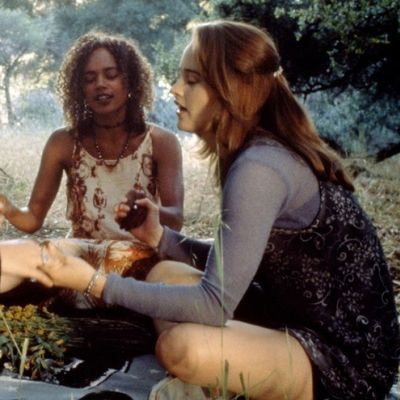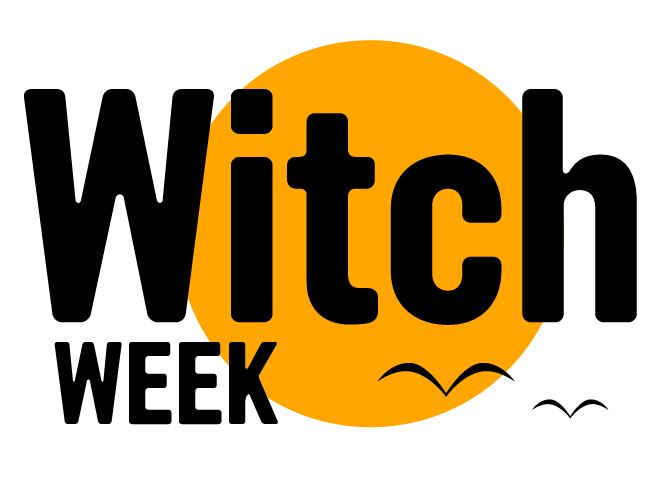
In TV, movies, and real life, women have been at the forefront of the year’s biggest stories — so this Halloween season, we’re looking at pop culture’s most wicked depiction of female power.
The first picture that comes to mind of The Craft is of its four main cast members, leaning with vulgar elegance against a brightly colored mural somewhere in Los Angeles. Their school uniforms are a bit rumpled, some hidden by dark, oversize jackets or sweaters knotted at their waist. Three of the young women — played by actresses Robin Tunney, Rachel True, and Neve Campbell — stare dead into the camera. Their expressions are brimming with defiance and anger, as if they’re challenging you to a confrontation. Nancy Downs though (played with equal parts blistering anger and touching vulnerability by Fairuza Balk) is staring to the side as if something has caught her attention, her eyes trained on some distant horizon we aren’t privy to. Her face is solemn and a bit yearning, revealing the tenderness the character hides under her stylized aggression. This single picture represents all the reasons why The Craft has such a fierce hold on the generation of young girls who discovered it in conversation with peers or at candlelit slumber parties in the late 1990s — the brand of adolescent bravado it displays and its sense of sisterhood.
In Entertainment Weekly’s oral history of the film, Tunney, who plays Sarah Bailey, touched on its legacy: “Somehow it still speaks to everybody’s inner teenage girl. I went to a bachelorette party where everybody had to bring their guilty-pleasure movies, and Natalie Portman brought The Craft.” When the film came out, the reviews were middling at best: It was described as “campy,” its imagination limited. But since The Craft was released in 1996, it has become a cult classic, spawning fan art, fanfiction, Etsy merchandise, and cosplay; it holds a reputation as the kind of film best kept to slumber parties between wine-drunk girlfriends, not serious study. But The Craft is more complex than its status as a guilty-pleasure artifact of 1990s cool would indicate. It taps into the primal American fear of female power, and what happens when women are alone together, forming hothouse bonds that seem to only occur in adolescence in ways that are both profound and contradictory, liberating and limiting.
The Craft, directed by Andrew Fleming and co-written by Peter Filardi, centers on Sarah Bailey (Tunney), who moves to Los Angeles for a fresh start with her father and stepmother after she attempts suicide. She struggles to find a place for herself in her new Catholic high school and finds a surprising communion with three outsiders who believe she’s the natural witch meant to complete their coven — Bonnie (Campbell), Rochelle (True), and Nancy (Balk). Each girl is electrified by the possibilities magic can bring, freeing them from a nexus of thorny issues that plague their adolescence — racism, poverty, physical scars, emotional wounds they’ve yet to heal from. For a brief moment in time, they find sanctuary in each other’s presence, until Nancy’s quest for power grows uncontrollable, warping the once precious, sisterly bonds they shared and sending them tumbling down a dangerous path. The Craft earned a generation of devoted fans because of how it charts the friendship between these four girls — its tentative beginnings, the joys of its strength, and its ultimate downfall — in ways that ring true for any young woman who has had a sisterly connection grow painfully toxic.
One of its most memorable scenes in this regard is a sleepover at Bonnie’s home. It effortlessly communicates the bliss that comes from the more simple, yet fiercely important friendships that bloom between young girls in high school. As they eat candy, smoke, and make lewd jokes, they grant the film its authenticity. Sarah suggests a game that’s actually more of a ritual: Rochelle lays down while her friends chant “light as a feather, stiff as a board,” their fingers tucked underneath her as they close their eyes in concentration. When they open their eyes to see she’s levitating, their faces move from shock to delight as they realize the power that comes when they join together.
The scene that follows is a montage of the girls that hits its apex with a classic teen-film trope: the slow-motion walk through school. Their faces are exuberant, bright with empowerment. They’re transformed. This is the peak of their sisterly bond before things go to rot. It’s the way the film interrogates how such close connections form between teenage girls — and then easily dissolve under the weight of the world — that grants The Craft its power.
Witchcraft is more than mere teenage rebellion for these young girls. It’s a means to attain what at first glance appears unattainable: power, control, autonomy, the ability to live beyond the various oppressive forces that govern their lives. For many girls, witches are our first brush with any depiction of feminism and the price women pay in searching for control over our lives. Whether they’re unhinged old women cackling into the night sky or alluring vixens, witches teach us the glory and risk that comes with power for a woman. They give voice to the darker desires you’re too young to name, and the anger swelling in your chest when the people in your orbit assume you lack the grit and intelligence necessary to make your desires a reality. Each of the girls is weighed down by the expectations and prejudices the world beyond their coven burdens them with, particularly the three original members of the coven. As the only black girl at the school, Rochelle faces racism. Bonnie struggles with a heavily scarred body that others either avoid looking at or tease her for. Nancy navigates being poor, an obvious bout of depression, and having no allies beyond the members of the coven she had an important hand in forming.
But Sarah’s presence disrupts the delicate balance of the coven. Her status as a natural witch, who leans toward the light and aids the other girls, makes Nancy feel discarded. She becomes power-hungry and turns Sarah into her target. It’s a brutal, but understandable turn. That Bonnie and Rochelle easily fall into step with her, despite the kindness Sarah has shown them, may be cruel, but young girls typically don’t get access to the sort of joy that Nancy offers them, where rules feel inconsequential. They can’t gloriously fuck up the way young men do and survive unscathed. There is no female equivalent of that troublesome “boys will be boys” adage. Of course Nancy revels in the darkness, and the others fall under its sway — it’s the first time they’ve felt any sort of liberation. They aren’t looking for reason or safety or kindness — they want freedom.
Many of The Craft’s strengths lie in how it charts the delicate bonds between these girls, but it is undoubtedly Fairuza Balk’s fierce performance that is perhaps The Craft’s greatest legacy.
I fell for Nancy because she mirrored my own adolescent struggles. She was poor, lonely as hell, and paranoid that what friendships she did have would be taken from her by someone more powerful and easier to love. Nancy’s greatest mistake isn’t the darkness that overtakes her, but that she refuses to play by the rules society lays out for her. Her step-father is an abusive creep. Her mother is too self-involved to notice Nancy’s cries for help. Everyone else is too afraid of Nancy to understand her, and it isn’t like she’d let them close enough to anyway. It’s Balk’s performance that grants this story its potency. She’s tender yet terrifying, maniacally intense, yet resolutely focused on exploring the joys that have mostly been withheld from her. The best showcase for Balk’s skills comes when Nancy decides to exact revenge on Chris for how callously he treated her, and his attempt to rape Sarah. But like how she approaches everything in life, she goes too far. After Chris rebuffs her attempt at seduction, pushing her off the bed, she curls into herself, looking like a wounded animal, until a the spark of realization crosses her face. She glamors herself to look like Sarah, and he’s easily won over. There is something delightfully unhinged about Nancy as the scene tips into horror: Her pointy-toed black boots scraping against the floor, her body moving with unnatural grace, her face split by a cheshire grin that communicates just how much vengeance she’s capable of. She’s a beguiling and fearsome portrait of female anger as she sends Chris hurtling to his death from a window.
That Nancy ends up crazed and strapped to a bed in a mental institution is a painful reminder that for women like her, who refuse to fit any mold of femininity society affords them, power is illusory, and second chances are an impossibility. That Nancy’s fate is such a prosaic, retrograde handling of a mentally ill, intensely iconoclastic woman’s narrative undercuts the compassion of the rest of the film. I like to imagine a different ending, one in which the coven stays together, and Nancy finds hope within their sisterhood, and a better use for her abilities.
Still, the film remains memorable for moments like the one where the young girls perform their beachside ritual during a thunderstorm, the camera spinning in dizzying circles, their arms outstretched. It isn’t merely supernatural prowess they’re reaching their arms toward. These girls, each in their own way, is calling out for something women learn early and often is hard to attain: the power to control your own life. And for a brief, glimmering moment, The Craft depicts the wonder and joy that comes with such autonomy, which isn’t only possible, but worth the risk.



